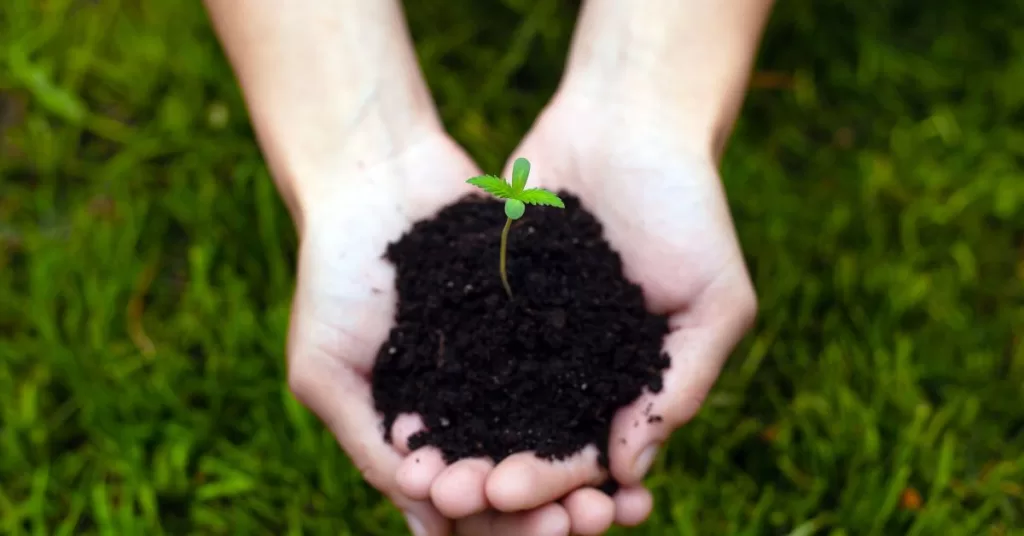Cannabis cultivation has been around for centuries, and with the legalization of cannabis in many parts of the world, it has become a booming industry.
However, the environmental impact of cannabis cultivation is a growing concern. The cultivation of cannabis requires significant resources, including energy, water, and land, which can negatively affect the environment.
One of the main environmental impacts of cannabis cultivation is its carbon footprint. The production of cannabis requires significant amounts of energy, particularly in indoor cultivation facilities.
These facilities require high lighting, heating, and cooling levels, which can contribute to significant carbon emissions.
In addition, using fossil fuels to power these facilities further exacerbates the carbon footprint of cannabis cultivation.
Table of Contents
The Carbon Footprint of Cannabis Cultivation

Cannabis cultivation has a significant carbon footprint, which can have a negative impact on the environment.
This is largely due to the energy-intensive nature of indoor cultivation, which often requires high-powered lighting and climate control systems. Additionally, the use of synthetic fertilizers and pesticides can also contribute to greenhouse gas emissions.
As the cannabis industry grows and matures, growers need to adopt sustainable cannabis solutions to minimize their carbon footprint.
This can include using renewable energy sources like solar power, implementing energy-efficient lighting and climate control systems, and using natural inputs like organic fertilizers to reduce the use of synthetic chemicals.
By adopting sustainable cannabis solutions, growers can help to reduce the environmental impact of cannabis cultivation and promote a more sustainable and responsible industry.
Water Usage and Conservation in Cannabis Cultivation
Water usage and conservation are important considerations in cannabis cultivation, as the plant requires significant water to grow and thrive.
In addition, water scarcity is a growing concern in many regions, making it crucial for growers to use water resources efficiently and responsibly.
One way to conserve water in cannabis cultivation is through efficient irrigation systems, such as drip irrigation or micro-sprinklers, which can help reduce water waste and ensure that plants receive the necessary water.
Growers can also implement water recycling systems, which capture and reuse water that would otherwise be wasted.
Additionally, the selection of drought-tolerant cannabis strains and the use of organic soil amendments can help to reduce the amount of water required for cultivation. Organic amendments like compost can improve soil structure and water retention, allowing plants to absorb better and utilize water.
Pesticides and Herbicides in Cannabis Cultivation

Using pesticides and herbicides has a serious environmental impact on cannabis cultivation and health consequences, as these chemicals can leach into the soil and water and potentially harm wildlife and humans.
In addition, the overuse of pesticides and herbicides can lead to resistance in pests and weeds, making it increasingly difficult to control them.
Organic and sustainable cannabis solutions can help to reduce the need for pesticides and herbicides in cannabis cultivation. This can include using natural pest management techniques, such as companion planting, physical barriers, and biological controls, like predatory insects.
Additionally, using organic soil amendments and cover crops can help improve soil health and reduce weed growth, minimizing the need for herbicides.
When pesticides and herbicides are necessary, growers need to use them responsibly and in accordance with regulations.
This includes using only approved chemicals, following proper application procedures, and carefully monitoring for adverse effects.
Sustainable Cannabis Solutions for Greener Growing
Sustainable cannabis solutions for greener growing are becoming increasingly important as the cannabis industry continues to grow and mature.
These solutions focus on reducing the environmental impacts of cannabis cultivation while promoting producing high-quality and safe cannabis products.
One sustainable cannabis solution uses renewable energy sources like solar power to power lighting and climate control systems in indoor cultivation facilities. This can help to reduce energy consumption and greenhouse gas emissions associated with cannabis cultivation.
Another solution is using natural inputs like organic fertilizers, compost, and beneficial microorganisms to improve soil health and plant growth. This can help reduce synthetic chemicals’ use and promote a more sustainable and organic growing environment.
Water conservation and responsible water use are also important sustainable cannabis solutions. Efficient irrigation systems, water recycling, and drought-tolerant strains can help reduce water waste and ensure that plants receive the necessary water.
Finally, responsible waste management and recycling can help to minimize the amount of waste generated by marijuana and reduce the environmental impacts of cannabis.
This can include composting organic waste and properly disposing of hazardous materials.
The Role of Technology in Sustainable Cannabis Solutions

Technology can play a significant role in sustainable cannabis solutions by helping growers to optimize their operations, reduce their environmental impact, and improve the quality of their products.
One example of technology in sustainable cannabis solutions is the use of precision irrigation systems, which use sensors and data analytics to deliver the optimal amount of water to plants. This can help minimize water waste and ensure that plants receive the necessary water.
Another example is the use of LED lighting systems, which are more energy-efficient and can help to reduce energy consumption and greenhouse gas emissions in indoor cultivation facilities.
Data analytics and automation can also help growers to optimize their cultivation operations and reduce waste. This can include monitoring plant growth and nutrient uptake, predicting crop yields, and identifying areas for improvement.
Finally, technology can also play a role in ensuring the safety and quality of cannabis products. This can include lab testing and blockchain technology to track the entire cultivation process and ensure products are free from harmful contaminants.
The Benefits of Sustainable Cannabis Solutions for the Environment and Industry
Sustainable cannabis solutions offer a range of benefits for both the environment and the industry. By adopting environmentally friendly practices, growers can reduce their carbon footprint, conserve water resources, and reduce the use of harmful chemicals.
This helps protect natural ecosystems and promote soil health while ensuring the safety and quality of cannabis products.
In addition, sustainable cannabis solutions can also help growers to reduce costs, increase yields, and meet the demands of socially conscious consumers.
As the cannabis industry grows, sustainable cultivation practices will become increasingly important for environmental and economic reasons.
The Future of Sustainable Cannabis Cultivation
The future of sustainable cannabis cultivation looks promising as the industry shifts towards environmentally-friendly practices.
The use of renewable energy sources like solar power is expected to increase. At the same time, adopting organic and natural inputs like compost and cover crops is likely to become more widespread.
Water conservation, responsible water use, waste management, and recycling will also be a priority.
Government regulations and policies will continue to play a key role in promoting sustainable cultivation practices. With socially conscious consumers driving demand for sustainably grown products, growers prioritizing sustainability will be better positioned to succeed in the industry.
Government Regulations and Policies on Sustainable Cannabis Cultivation
The government is important in promoting sustainable cannabis cultivation practices through regulations and policies.
Many jurisdictions require cannabis growers to comply with environmental standards related to air quality, water use, waste management, and energy consumption.
Some governments also offer grants and incentives for growers who adopt sustainable practices. Social equity programs are implemented to ensure marginalized communities have access to opportunities in the cannabis industry.
Finally, government regulations can ensure the safety and quality of cannabis products by testing for harmful contaminants and regulating labeling and packaging.
Conclusion – The Importance of Sustainable Cannabis Cultivation for a Greener Future
The environmental impact of cannabis cultivation is a growing concern, but sustainable solutions are available for greener growing.
By implementing sustainable practices, such as organic cultivation practices, renewable energy sources, and water-efficient methods, cannabis cultivators can significantly reduce their environmental impact and contribute to a greener future.
As the cannabis industry continues to grow, prioritizing sustainability will become increasingly important for the industry’s success and the health of our planet.
